The market for ride-hailing services is growing rapidly worldwide, and applications such as Bolt, Uber and Lyft are transforming the concept of urban transportation. It is estimated that the ride-sharing industry will have a global revenue of $185.1 billion by 2026 because of growing urbanization and the penetration of smartphones.
Bolt is one of the fastest-growing mobility disruption platforms, with operations in more than 45 countries.
It has a lean operating model, multi-service offerings, and a user-first strategy, making it one of the strongest competitors in the global mobility game.
Entrepreneurs who wish to develop app like Bolt need to learn more about its architecture, functionality, and monetization options.
No matter if your aim is to develop Bolt clone app or a bespoke mobility solution, this blog will provide a full set of features, tech stack, cost estimation, and success tips.
Bolt is one of the most well-known ride-hailing and mobility providers in Europe, providing services such as taxis, e-scooters, car-sharing, and food delivery.
Initially introduced as Taxify in 2013, Bolt allows passengers to access drivers or mobility services in their vicinity with the help of an easy-to-use mobile app.
The customizable functionality and scalable model have attracted the attention of entrepreneurs wanting to develop app like Bolt.
Upon opening the app, a user provides his/her pickup and destination information. The algorithm of Bolt then connects them to the closest available driver based on real-time GPS location tracking. This reduces wait time and guarantees optimum routes.
One of the main reasons why many businesses seek to develop Bolt clone app with a similar logic is the smooth matching process.
After matching, the app shows the name of the driver, photo, type of a car and the license plate. The riders are also able to see the rating of the driver and estimated time of arrival (ETA). This boosts trust and introduces transparency.
To develop app like Bolt, real-time driver insights are imperative in terms of safety, accountability, and user satisfaction.
Users are able to follow their journey live on a map during the trip. They can also provide the family or friends with the details of their trip to ensure extra safety.
Live tracking is not only a user-friendly feature; it is an important part of ride safety and driver compliance and is, therefore, a fundamental component when planning to develop Bolt clone app.
Bolt has several payment methods such as credit/debit cards, mobile wallets, and in certain areas, cash. The payment is done immediately after the ride, and there is an automatic fare breakdown. When you intend to build app like Bolt, you must ensure secure and flexible payment gateways both locally and internationally.
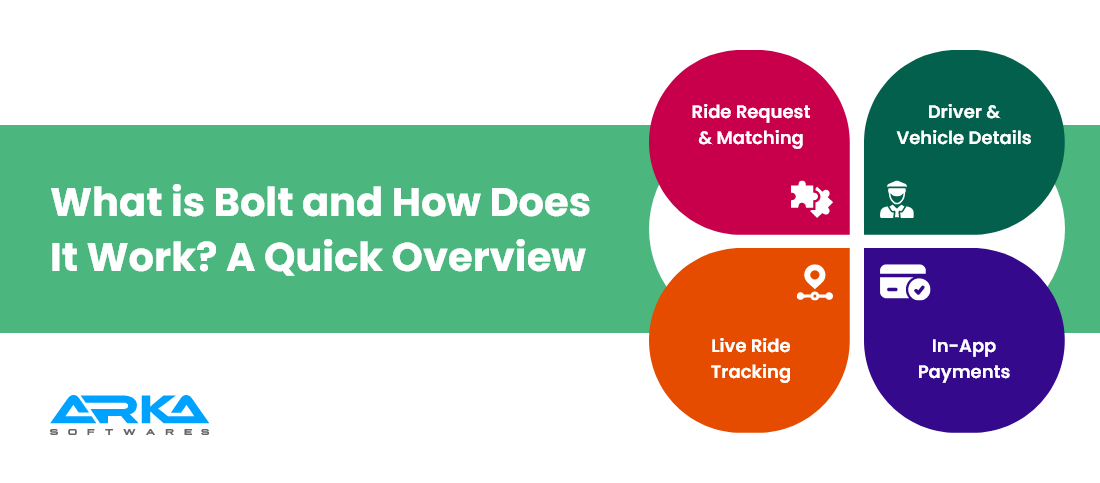
Markus Villig, a 19-year-old entrepreneur, started Bolt in Tallinn, Estonia, in 2013 to address the lack of taxi availability in undeveloped European markets.
Originally called Taxify, the platform aimed at addressing the problems of inefficiencies within the traditional taxi industry through mobile first solutions.
The thing that made Bolt stand out initially was its emphasis on affordable and locally controlled ride-hailing services.
When big companies were fighting to take over big cities, Taxify targeted underserved markets, such as Eastern Europe and Africa.
Villig created the initial MVP with a €5,000 seed funding given by his family and a small development team. The early success of the company was based on its lean structure and commission-friendly rates.
With time, Bolt enhanced its services and rebranded in 2019, reflecting its bigger vision of covering e-scooters, food delivery, and car-sharing. Nowadays, its achievements motivate other entrepreneurs to develop app like Bolt and replicate its localized, multi-service ecosystem.
Throughout its journey, Bolt has drawn the attention of investors. The following are some highlights of its key funding events.
Markus Villig started Bolt with a €5,000 loan provided by parents, validated product-market fit in small markets, and secured angel money.
Raised significant investment by Daimler and Didi Chuxing, which enabled Bolt to enter Africa and Europe, where it became a serious Uber rival in the emerging markets.
Collected a total of more than $400 million from investors such as Naya Capital, Creandum, and IFC, which contributed to the development of the product and to new directions, such as food delivery and scooters.
Bolt raised a $713 million round, led by Sequoia Capital and D1 Capital, taking its valuation to $8.4 billion, to be used on expansion and R&D.
The rapid growth and diversification of services has characterized Bolt in its quest to achieve world prominence. In 2016, it was established in over 10 countries such as Latvia, South Africa, and Nigeria.
In 2018, Bolt launched electric scooters, becoming one of the first ride-hailing companies to enter micro-mobility. In 2019, the company formally changed its name to Bolt, replacing Taxify, to reflect its transformation into a company that offered more than just cars and rides, but rather a mobility provider.
By 2021, Bolt had more than 100 million users in 500+ cities and 45+ countries.
It also expanded its value proposition by launching Bolt Market, which is a 15-minute grocery delivery service. Today, Bolt has many businesses such as ride-hailing, food delivery, car rental, and e-scooters in one app.
Its dynamic growth and multi-vertical business strategy can serve as an effective guideline to startups and tech founders who intend to develop app like Bolt in domestic markets.

Knowing the monetization structure of the platform before you build app like Bolt is important. The following is a breakdown of the core revenue streams of Bolt.
Bolt levies a commission fee on drivers, which is usually between 15-20% of a ride. This percentage is automatically deducted from the fare before the driver gets his earnings. The relative low commission that Bolt charges compared to its competitors is useful in attracting and retaining drivers. For entrepreneurs who intend to develop app like Bolt, this fee structure is the foundation of monetization and platform sustainability.
On days of high demand (e.g., rush hours, bad weather), Bolt introduces surge pricing to raise prices. This will not only ensure there is equilibrium between demand and supply, but also increase the revenue per ride of the company.
The app does this in real-time depending on location, traffic and driver availability. Dynamic pricing is one of the most important things you need to implement to remain competitive when you develop Bolt clone app.
In certain markets, Bolt provides weekly or monthly subscriptions to drivers as an alternative to commission-based per-ride. Drivers pay a flat fee to use the platform and retain 100% of their fare.
The model guarantees Bolt consistent revenue and drivers a higher predictability of earnings. Having such a flexible model in your custom Bolt clone app can improve driver retention.
The company generates its revenue through food and grocery delivery business – Bolt Food and Bolt Market, charging restaurants and grocery stores a commission, and delivery fees to its customers.
Other revenues are received through priority listing charges and advertising promotions. By introducing similar delivery services, entrepreneurs wanting to develop app like Bolt can increase revenue to a considerable extent.
Bolt makes money through advertising placement of restaurants, shops, and third-party brands within its application. Such placements are location and user behavior targeted, and therefore, are highly valuable.
When you build app like Bolt, you will have an opportunity to introduce ad placements as a new source of monetization without affecting the experience.
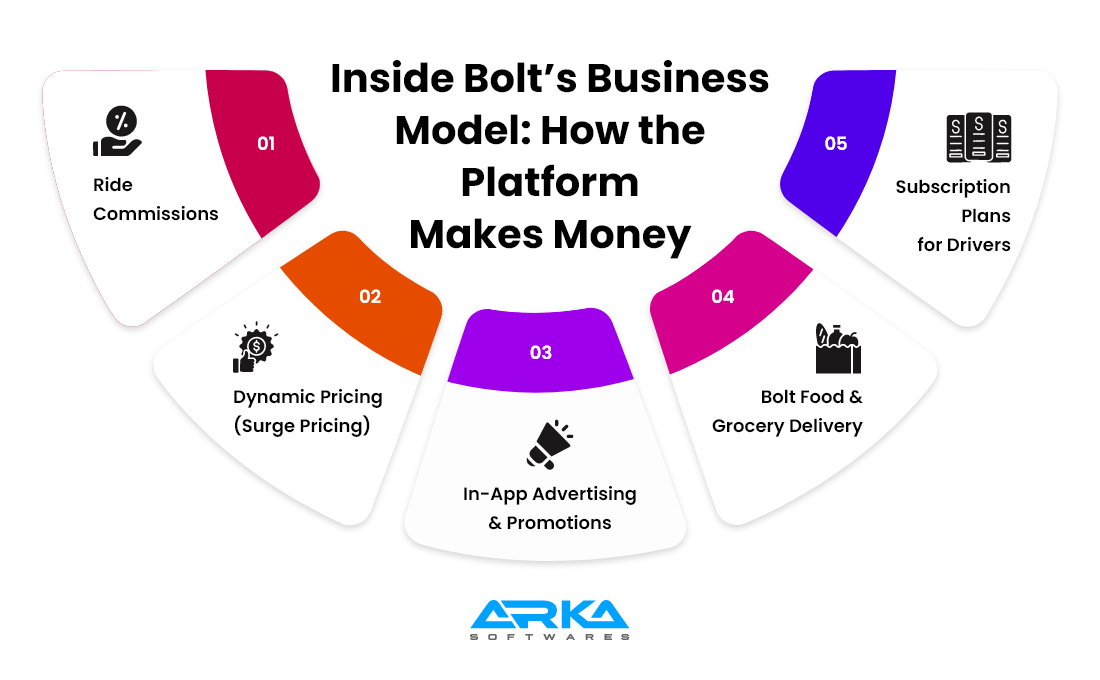
To create a successful ride-hailing solution such as Bolt, a flashy interface is not enough. You should have a strategic vision, technical accuracy, and a user centered approach.
When planning to develop app like Bolt, it is crucial to adhere to a systematic approach of development to guarantee the scalability, functionality, and profitability of the app.
Start by conducting a study of the local or target market to know the demand, the competition and user behaviour.
Determine the pain points that may not be covered by apps like Bolt such as price, reliability of the service, or unserved areas.
This understanding assists in developing your distinct values and attributes. This stage of market validation enhances the odds of success when you develop Bolt clone app.
List the essential features for riders, drivers, and admins. These usually consist of real-time monitoring, fare forecasting, payment and ride history.
You should also think about modules such as driver onboarding, customer support, or fleet management.
The decisiveness of features during this stage means that your development team can build app like Bolt efficiently with minimal iteration.
Make UI/UX smart and dynamic across all user panels. The rider application should provide convenient booking and tracking of the ride, whereas the driver one should be devoted to the availability, navigation, and payments.
Smooth user experience has a direct correlation with app retention. An amazing design is what makes the difference between mediocre and successful platforms such as Bolt and it is something you absolutely need when you develop app like Bolt.
Select a scalable, trustworthy tech stack, such as React Native as the cross-platform framework and Node.js, MongoDB, Firebase, and AWS as backend and hosting. Connect APIs of maps, geolocation, payment gateway and notifications.
A well-built tech stack is essential in order to handle high traffic and data operations, and it is less difficult to clone app like Bolt that works well in real-life situations.
Make a simple version of your Bolt clone app with minimum features. This enables you to develop fast, gather user insights, and test your business idea through real users.
MVP development is less risky, cost-saving, and allows you to iterate according to the market demand. This lean strategy is best suited when you are beginning to make an app like Bolt.
Perform extensive testing on bugs, crashes and bottlenecks. Make sure that the app should comply with all the local laws such as data privacy, payment compliance, and driver safety standards. It is mandatory to have strong encryption and safe API integrations.
These factors guarantee reliability, customer satisfaction, and sustainability when you develop app like Bolt.
Once your app is launched, monitor the application usage, exit points, and customer behavior with the help of analytics tools.
Use feedback from riders and drivers to prioritize future updates. Keep enhancing the performance, features and UI. A data-based growth cycle makes your Bolt clone app competitive and up-to-date in a rapidly changing market.
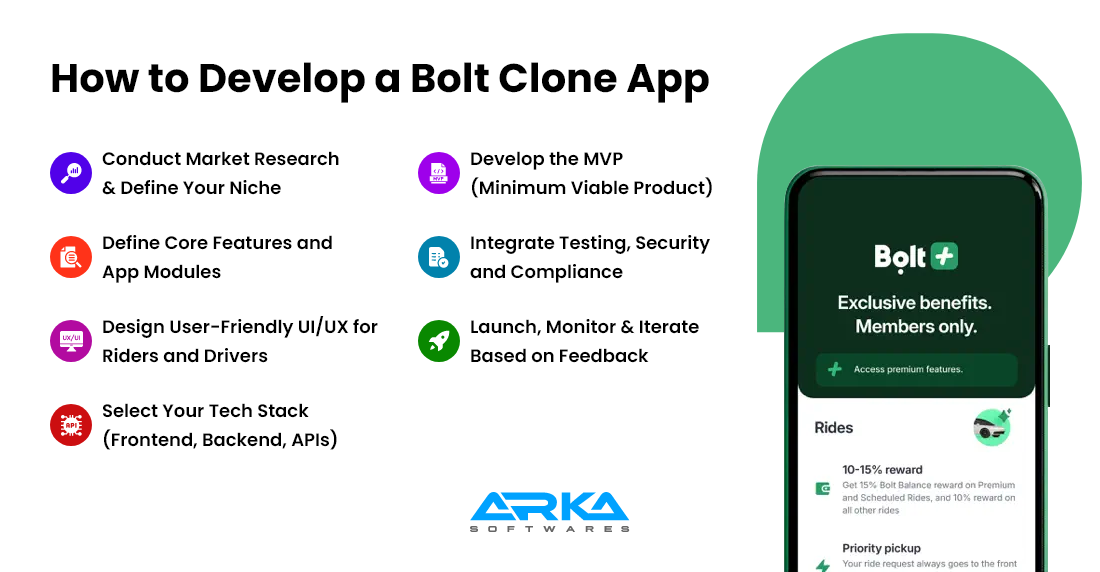
Regardless of whether you are developing an MVP or a fully functional platform, it is important to incorporate the necessary features for the riders, drivers, and admins. The following are the essential elements of an effective custom Bolt clone app.
User onboarding should be one-click with phone number, email or social authentication. The app should allow users to handle profiles, payment modes, history of rides, and preferences. It enhances security and trust with proper KYC and authentication procedures.
An efficient user module guarantees ease of access, customization, and retention, which are the most crucial factors when you create ride sharing taxi Bolt app.
Enable users to make real-time reservations by keying in pick and drop points using the GPS. A user-friendly interface must then pair them with the closest vehicle in real-time based on geographical information.
Any Bolt like taxi app is built on a responsive ride-request system, which enables a better user experience and higher ride volumes to grow faster.
The process of integrating real-time tracking will allow users and drivers to see the live route of the trip through the map view. The visibility and control are increased through features such as ETA, the distance covered, and route optimization through APIs (such as Google Maps).
This not only builds user trust but is also expected when you build app like Bolt.
Your app is supposed to dynamically calculate the trip fare using distance, time and traffic to calculate. Include a range of payment methods like credit/debit cards, digital wallets, and cash. When planning to develop app like Bolt, in particular, to work with international or diverse audiences, one of the essential functions is flexible and transparent pricing.
An independent driver module will be essential in terms of handling ride requests, earning, navigation, and performance analytics. This extends to switching availability, checking history of trips, and getting payout reports.
The best ridesharing apps have to equip their drivers with a powerful interface as driver satisfaction directly influences service quality and supply.
You will have easy access to drivers, users, ride requests, pricing models, payouts, and dispute resolution through a centralized admin dashboard. It must have decision-making and operational analytics.
A powerful admin panel is a mandatory feature of any clone app like Bolt, which will guarantee seamless backend functionality and scalability of the system.
The post-ride feedback allows users to rate drivers and leave comments, which allows you to track the quality of the services and the conduct of drivers. This loop of feedback is very essential in ensuring the community standards and better operations.
An effective ride sharing Bolt app has a feedback system that creates trust and improves services.
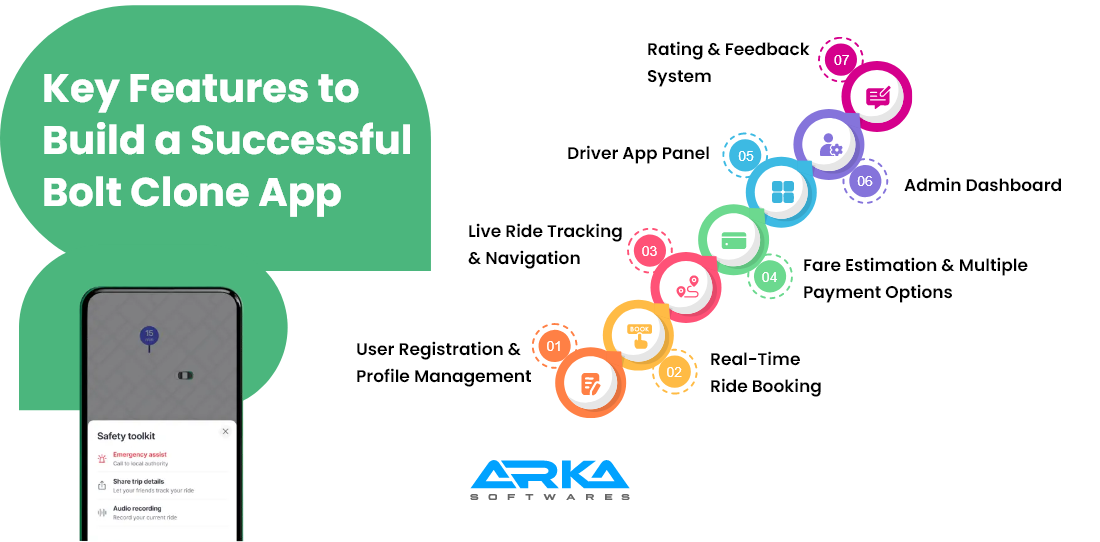
When you intend to develop app like Bolt, it is essential to select the right technology stack. It makes your platform secure, fast, scalable and flexible to incorporate future upgrades. The following is an example of a robust tech stack that can be used to develop a reliable and robust custom Bolt clone app.
| App Component | Recommended Technologies |
|---|---|
| Frontend (User & Driver Apps) | React Native, Flutter (for cross-platform); Swift (iOS), Kotlin (Android) |
| Backend | Node.js, Express.js, or Django with Python |
| Real-Time Tracking & Maps | Google Maps API, Mapbox, OpenStreetMap, GeoFire for live location tracking |
| Database | PostgreSQL, MongoDB for structured and unstructured data |
| Authentication | Firebase Auth, OAuth 2.0, JWT (JSON Web Tokens) |
| Payment Gateway | Stripe, Razorpay, Braintree, PayPal, Flutterwave (for local/international support) |
| Cloud Hosting | AWS (Amazon Web Services), Google Cloud Platform, Microsoft Azure |
The cost to develop a Bolt clone app differs greatly, based on the complexity of the app, the features, and the method of development.
Regardless of whether you are going to develop a simple MVP or a full-scale multi-service platform, knowledge of the cost model will assist you in planning more effectively. The three main cost factors are as follows:
A simple Bolt-like ride-hailing app with rider and driver modules can range between $20,000 to $40,000. But when you add real-time tracking, surge pricing, multi-language, and multi-service integrations (such as food delivery or scooter rentals), this may cost up to $80,000 and higher. Complex UI/UX, administration dashboards, and cross-platform functionality also contribute much to the cost to build Bolt app.
The location and mode of hiring your development team determines a large part in your cost. The cost of hiring a U.S. based agency may be $100-$150/ hour but offshore software development teams in India, Eastern Europe or Southeast Asia will charge between $20-$50/hour.
For startups looking to control the cost to develop taxi app, offshore collaboration is a cost-effective and scalable solution.
Do not forget about post-launch costs such as bug fixes, server hosting, app updates, third-party API costs, and support. Software maintenance cost contributes approximately 15-20% on average to the software development cost each year.
App maintenance guarantees long-term performance, scalability, and security of your Bolt clone app.

When you want to join the ride-hailing industry fast and at a reasonable price, a Bolt clone can help you make the right decision, as opposed to developing an app of your own.
This is why entrepreneurs and startups prefer to develop a clone app like Bolt over a full custom development.
A Bolt clone has ready-to-deploy core functionality that makes it easier to launch within weeks, rather than months.
A lot of the codebase is already built and tested, so you can skip the time-consuming cycles of research, UI/UX design, and backend development that custom Bolt application development usually involves.
The upfront cost of a pre-built Bolt clone script is minimal as opposed to custom-built solutions.
You do not have to incur the cost of creating a design, writing code lines of each module, and testing of every unit, which makes it an ideal solution for startups with small budgets.
Bolt has a successful model that can be replicated in mobility businesses. A clone app will enable you to make a copy of what is already successful in the market.
When you create ride sharing app like Bolt, you can pay attention to localization and the features that fit your market, instead of blindly experimenting with unknown user flows.
Although you begin with a clone, it can be fully customized and scaled to your needs with modern solutions. It is simple to introduce new features, payment methods, or even verticals such as food delivery.
This is to say that your Bolt clone app development is not restrictive to growth, instead, it gives you a solid foundation to grow as your company expands.
Choosing the right development partner is just as important as the idea itself. To develop app like Bolt successfully, you’ll need a team that understands ride-hailing, real-time systems, and scalable architecture.
Choose a team with proven experience in on-demand taxi app development services. Review their case studies or ask for live demos of similar projects.
Teams with experience in apps similar to Bolt will understand your project’s technical, UX, and operational nuances far better than a generalist software agency.
Study their past work, app UI/UX, and functionality. Look for Bolt clone script providers with a track record of high user retention and performance.
Also, review client testimonials on Clutch, GoodFirms, or Google to validate their credibility, support quality, and ability to develop Bolt clone app efficiently.
Ask for transparent, milestone-based pricing or fixed quotes. Avoid vague hourly rates without deliverables. Discuss the cost to develop a taxi app, and whether they offer MVP packages or flexible engagement models.
A reliable partner will help you manage your custom Bolt clone app budget wisely.
Ensure the team is proficient with modern tech stacks like React Native, Node.js, Firebase, and AWS. Ask whether they offer react native app development services for cross-platform compatibility.
The right team should suggest scalable architecture and third-party integrations essential to creating efficient ride-sharing app solutions.
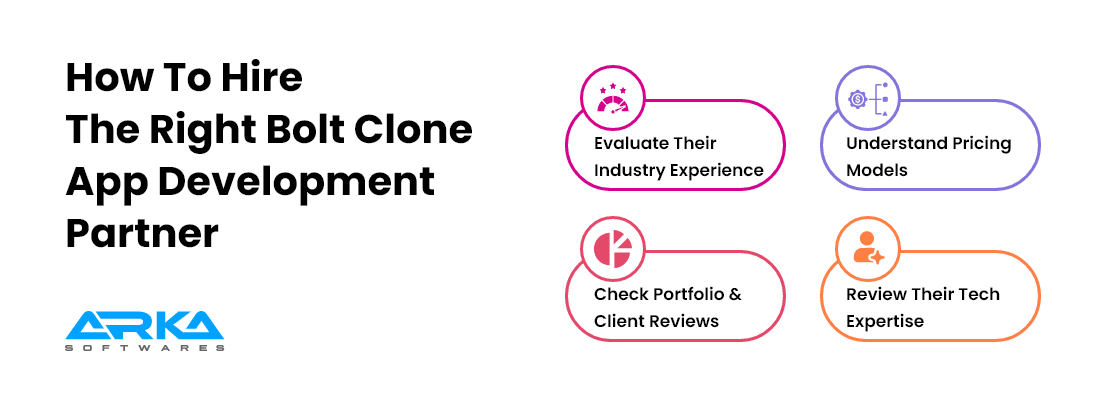
The success of Bolt has inspired a global wave of apps similar to Bolt. Developing an app like Bolt is a large market opportunity, but it takes planning, the right technology, and a mature development team.
To develop an app like Bolt that competes with your local market or niche market, you only need to ensure that you focus on UX, real-time features, scalability, and monetization. You might choose to make a custom Bolt clone app, or take a ready-made solution, but in any case, always make sure that your base is rock-solid to be able to scale with your user base.
Yes, most clone apps are fully customizable to fit your business needs and target audience.
Absolutely. Multi-language and currency options can be added via APIs or localization frameworks.
With encryption, secure APIs, and GDPR compliance, user data can be well-protected.
Around 6–10 weeks for MVP; longer if adding custom features.